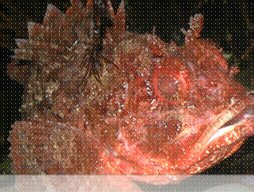| |
|
Plankton are midwater dwellers unable to swim against currents. They don't need to, since their world is a small volume of water around them, a little drifting world inhabited by tiny plants - unicellular microalgae, microscopic "herbivorous" and predatory animals - infusoria, amoebas, various crustaceans, invertebrate and fish larvae; their gametes and eggs; algal spores...
|
|

Dinophycean microalga Dinophysis caudata has large sails to sail in water column.
This dinoflagellate is common in spring to autumn phytoplankton in Black Sea . It produces diarrhetic toxins which can be accumulated by bivalve molluscs, including mussels.
|
Planos - is soaring, or sailing in Greek. They sail through the water, they struggle not to sink, since they're not accustomed to benthic life, they're eaten very fast if they approach bottom.
When even the unusually large Black Sea plankton animal, jellyfish Rhizostoma pulmo nears bottom, it is immediately gets attacked: the small crab Macropipus holsatus able to swim with its flattened rear legs, shoots up from the bottom to the jellyfish, settles on it, and travels on it while eating its flesh.
Planktonic algae need to keep in the sunlit upper layer of seawater - the photic zone, since the light gives them life: it's a fuel for their photosynthetic wonder-machine.
Planktonic organisms have different adaptations for staying in midwater: most of them have a body density close to that of water, e.g. jellyfish.
|
To slow down sinking many plankters also have an increased body surface area as related to the body volume, like small parachutes. Planktonic algae possess various kinds of cell surface projections: dinoflagellates of genus Dinophysis have wide sails, diatoms of genus Chaetoceros have long chaeta, and Dictyochophycean algae have long silicon spicules. Another way of increasin sailing surface is the formation of colonies by dividing cells of algae and bacteria. Usually they build chain colonies, some species make globular colony held together by mucous excretion of the cells like in Chaetoceros socialis.
|
Most plankters can swim. Although this mobility is insufficient to withstand currents, it allows microscopic prey avoid microscopic predators or in other cases allows predator - to reach a prey.
Many planktonic algae have flagella to propel them through the water; planktonic crustaceans row with their legs; infusoria, larvae of molluscs, echinoderms, and many worms have cilia to move them. Medusas project themselves upward pushing water out of their canopies, while ctenophores use thousands of rowing plates made of cilia.
The locomotion provides some of the plankton an ability to move up and down the water column; scyphozoan jellyfish, ctenophores, and most planktonic crustaceans can regulate their depth by active movement.
|

Aurelia aurita and Mnemiopsis leidyi - scyphozoans and ctenophores - large masses of gelatinous plankton at South Crimean coast.
|
Not all plankton is of microscopic size. Large jellyfish and comb jelly are plankton too. For the large gelatinous plankton it is as dangerous to move close to the sea surface as to the bottom, because even small waves disrupt their soft bodies. They go deeper when waves grow higher. To help regulate the right depth of submergence, jellyfish have statocysts, organs of equilibrium that indicate both the direction to bottom and report animal of wave disturbance. Scyphozoan jellyfish also possess simple eyes, informing animals of how close they are to the sea surface.
Sometimes currents and waves drive innumerable masses of jellyfish to the Black Sea shores. The portion of gelatinous plankton is unusually high in the Black Sea. The biomass of scyphozoans and ctenophores account for more than 90% of total zooplankton biomass in coastal Black Sea waters during the warm period of year, sometimes reaching over 1000 g m-3 of seawater (why it is so - Evolution of the Black Sea Ecosystem).
|

blenny larva
|
A few other plankters can be seen without the microscope. They include the elongated, glassy-transparent, agile Chetognate predator Sagitta; errant Polychaeta which become particularly conspicuous when gathering for spawning - most common plankton polychaeta in the Black Sea is Plathynereis dumerilii; a semi-transparent 5mm long larva of blenny - it's already similar to an adult fish.
|
|
Still the great majority of plankton species, in all their stunning diversity are creatures so small that we just can not see them, but, they do exist! They are in any drop of seawater we swim in, and in any little splash of sea wave breaking ashore.
We enter the world of these small plants and animals of Black Sea using a light microscope. To do that we first need to concentrate plankton: we sample it with plankton net made of fine 10 um mesh. Only the smallest unicellular algae and bacteria are able to pass trough it, the majority of plankton species is detained by the mesh. The easiest way to study coastal plankton is to filter large volume of surface, near-shore sea water through the net, e.g. we pass 100 liters of seawater trough the net, collecting the sample in a 0.5 L jar, concentrating it 200 times.
|

|
That's what we got in our sample. Unicellular microalgae, phytoplankton, and microscopic animals grazing phytoplankton - zooplankton: crustaceans, hydroid medusa...
|

A typical sample of late summer plankton in the Black Sea: a hydroid medusa Sarsia sp., copepod crustacean Oithona sp.; large Dinophycean microalgae Ceratium fusus (like cutlasses), smaller Prorocentrum sp., some of which are swallowed by Sarsia
|
|
|
|

